More than $5 million is earmarked in that bill for Butler County projects in Sub. HB 2, including $1 million for the redevelopment project of the former woolen mill at the corner of Pleasant and Williams avenues. Ohio Rep. Sara Carruthers, R-Hamilton, said that “securing these investments will ensure our future remains bright.”
“The redevelopment of the Shuler and Benninghofen Mill will be catalytic Lindenwald,” said Hamilton Economic Development Manager Jody Gunderson. “From the increase in quality housing options and the new retail and restaurant space for residents and visitors to enjoy, to the sense of pride that will come from redeveloping this 4-plus acre site in the heart of the business district into a thriving community hub, this project will be a game changer.”
Hamilton city officials have been working since 2019 with the Cincinnati designs and development firm Bloomfield/Schon on the project. They are the same firm behind the American Can Lofts in Cincinnati and the Peters Cartridge Factory in Mainville (Warren County).
The proposed $24 million adaptive reuse of the former Shuler and Benninghofen site, which was built in 1894, is more than 4 acres in the heart of Lindenwald’s business district. The proposed redevelopment plan calls for 100-plus market-rate apartments, 10,000 square feet of commercial and restaurant space ― which Gunderson said would help economically reactivate the corner of Pleasant and Williams avenues ― and 50 indoor parking spaces.
The building was added to the National Register of Historic Places Registry, and the developer plans to apply for the Ohio Historic Preservation Tax Credit Program this fall. The state agency will announce awards for that round of tax credit recipients in December.
The state’s tax credit program has helped 673 projects rehabilitate 917 historic buildings in 91 Ohio communities. It leveraged more than $9.84 billion in private development. The fall 2023 round awarded credits to 54 historic buildings in 16 Ohio communities.
The competitive program receives applications twice a year, in the spring and the fall. Hamilton projects have been successful in landing historic tax credits, which have most recently been awarded to the Spooky Nook Sports Champion Mill and The Well House Hotel (formerly the Anthony Wayne).
Gunderson said the timeline for the project should be more solid once the historic tax credit announcements are made.
About the Author

